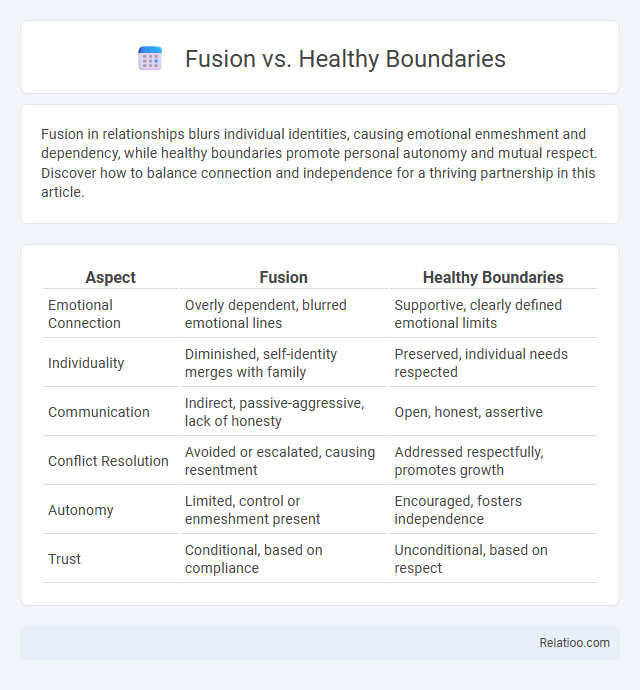Fusion in relationships blurs individual identities, causing emotional enmeshment and dependency, while healthy boundaries promote personal autonomy and mutual respect. Discover how to balance connection and independence for a thriving partnership in this article.
Table of Comparison
| Aspect | Fusion | Healthy Boundaries |
|---|---|---|
| Emotional Connection | Overly dependent, blurred emotional lines | Supportive, clearly defined emotional limits |
| Individuality | Diminished, self-identity merges with family | Preserved, individual needs respected |
| Communication | Indirect, passive-aggressive, lack of honesty | Open, honest, assertive |
| Conflict Resolution | Avoided or escalated, causing resentment | Addressed respectfully, promotes growth |
| Autonomy | Limited, control or enmeshment present | Encouraged, fosters independence |
| Trust | Conditional, based on compliance | Unconditional, based on respect |
Understanding Fusion in Relationships
Fusion in relationships occurs when personal boundaries dissolve, causing partners to lose individual identity and emotional autonomy. Healthy boundaries, by contrast, maintain distinct selfhood while fostering intimacy through respect and clear communication. Understanding fusion involves recognizing enmeshment patterns that undermine independence, leading to codependency and impaired emotional regulation.
What Are Healthy Boundaries?
Healthy boundaries are clear, respectful limits people set to protect their emotional well-being and foster balanced relationships. Unlike fusion, where individuals lose their sense of self by overly merging identities and emotions, healthy boundaries maintain individuality while promoting connection and mutual respect. Establishing healthy boundaries prevents enmeshment and supports personal autonomy within social and intimate connections.
Key Differences Between Fusion and Healthy Boundaries
Fusion occurs when personal identities and emotions become intertwined, leading to a loss of individuality and emotional autonomy. Healthy boundaries preserve your sense of self by establishing clear limits that promote respect and emotional independence within relationships. The key difference lies in fusion's blurred lines causing dependency, while healthy boundaries maintain distinct identities and foster balanced connections.
Signs You May Be Experiencing Relationship Fusion
Experiencing relationship fusion often involves losing your sense of individuality as your emotions and decisions become heavily dependent on your partner's feelings, leading to blurred personal boundaries. Signs of fusion include constantly seeking approval, feeling anxious when apart, and an inability to set or maintain healthy boundaries that protect your emotional well-being. Recognizing these symptoms allows your relationships to shift towards healthy boundaries, where mutual respect and personal space create a balanced and supportive connection.
Benefits of Setting Healthy Boundaries
Setting healthy boundaries protects your emotional well-being by clearly defining limits in relationships, preventing emotional enmeshment typical in fusion. This separation fosters personal growth, self-respect, and mutual understanding, enhancing both individual independence and connection quality. You gain control over your life, reduce stress, and promote balanced interactions by maintaining these boundaries.
Emotional Consequences of Fusion
Emotional fusion in relationships often leads to blurred personal boundaries, resulting in heightened anxiety, loss of self-identity, and codependency, which can undermine emotional well-being. Healthy boundaries allow your emotions to remain distinct and manageable, promoting self-awareness and resilience without emotional enmeshment. Understanding the emotional consequences of fusion is crucial for fostering relationships that support individual growth and genuine connection.
The Role of Communication in Maintaining Boundaries
Effective communication plays a crucial role in maintaining healthy boundaries by clearly expressing personal needs and limits without overstepping individual autonomy. In fusion, communication becomes blurred or enmeshed, making it difficult to distinguish where one person ends and another begins, which undermines self-identity. Establishing and respecting boundaries through direct, honest dialogue helps prevent fusion and promotes emotional independence and mutual respect.
Overcoming Challenges in Setting Boundaries
Overcoming challenges in setting boundaries requires recognizing the difference between fusion, where emotional entanglement blurs your identity, and healthy boundaries that maintain autonomy and respect. Your ability to establish clear limits fosters personal growth and reduces codependency, enabling healthier relationships. Cultivating self-awareness and assertiveness helps navigate the discomfort often associated with boundary-setting to promote emotional well-being.
Steps to Move from Fusion to Healthy Boundaries
Establishing healthy boundaries begins with recognizing emotional fusion patterns where personal identities and feelings overlap excessively. Steps include increasing self-awareness through mindfulness practices and setting clear physical, emotional, and mental limits that honor individual needs without sacrificing connection. Consistent communication and assertiveness training support maintaining boundaries, fostering balanced relationships free from enmeshment and dependency.
Building Relationships Based on Respect and Individuality
Building relationships based on respect and individuality requires distinguishing healthy boundaries from fusion, where emotional enmeshment blurs personal identities. Healthy boundaries promote autonomy and mutual respect, allowing each person to maintain their unique identity while fostering emotional connection. Fusion, by contrast, undermines individuality, leading to dependency and blurred limits that can hinder personal growth and authentic relational dynamics.

Infographic: Fusion vs Healthy Boundaries
 relatioo.com
relatioo.com